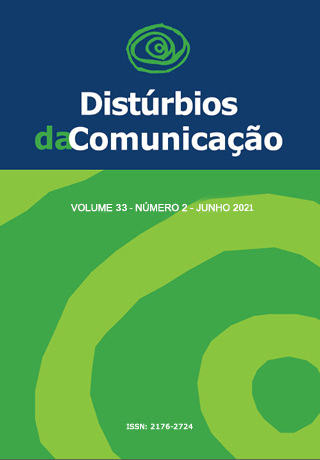Case series study on voice and transsexuality: acoustic characteristics of Brazilian trans men and women
DOI:
https://doi.org/10.23925/2176-2724.2021v33i2p257-264Keywords:
Voice, Voice Quality, Transsexuality, Formants, Speech, Language and Hearing Sciences, DysphoniaAbstract
Objective: To describe the acoustic characteristics in the voice of trans men and women. Method: Six trans subjects, two men and four trans women, aged over 18 years participated in this study. The SoundForge 10.0® software was used to edit and select the vowel /a/, the Advanced Multi-Dimensional Voice Program (MDVP-Adv) for extraction of measurements from computerized acoustic analysis, and the Analysis Synthesis Laboratory program (Computerized Speech Lab - Kay Pentax®) for analysis of the vocal filter. Results: Formant values were lower when compared to national and international literature. The measures of f0 presented values below that expected for the female gender and increased to the male gender. Regarding the measures of the highest fundamental frequency (fhi) and the lowest (flo), the results showed great variability, suggesting phonatory instability. The results of jitter and shimmer and noise-related parameters, such as Voice Turbulence Index (VTI) and Soft Phonation Index (SPI), were incongruent when related to normality parameters. The noise / harmonic NHR measurement showed to be higher than the normal values, suggesting the presence of noise or hoarseness during the emission. Measurements of vocal tremor (Fatr and Ftri), presented an abnormal distribution when compared to the literature. It was not possible to observe relations in the analysis of the acoustic characteristics between the reference values and the people participating in this research. Conclusion: The acoustic measures of voices of trans people present different analysis when compared to the literature, evidencing the fragility of acoustic vocal analysis programs that do not contemplate the cultural heterogeneity and the varied gender identities.
Downloads
References
Conselho Federal de Fonoaudiologia - CFFa. O que faz o fonoaudiólogo? [homepage na Internet]. Distrito Federal: Conselho Federal de Fonoaudiologia; 2015 [acesso em 5 out. 2018].Disponível em: http://www.fonoaudiologia.org/.
Dornelas R. Cunha, MC, Ghirardi ACAM. Voz e psiquismo: efeitos recíprocos em um paciente laringectomizado total. Distúrb da Comun. 2010; 22: 61-7.
Finger LS, Cielo CA, Schwarz K. Acoustic vocal measures in women without voice complaints and with normal larynxes. Braz J Otorhinolaryngol. 2009; 75(3): 432-40.
Mora R, Crippa B, Dellepiane A, Jankowski B. Effects of adenotonsillectomy on speech spectrum in children. Inter J of Pediatric Otorhinolaryngol. 2007; 71(8): 1299-304.
BRASIL. Conselho Nacional de Pesquisa. Portaria CONEP/MS nº 465 de 2012. Brasília, DF.
Behlau, M, Madazio G,Feijó D, Pontes P. Avaliação de Voz. In: Behlau, M. Voz: o livro do especialista.Vol 1. Rio de Janeiro: Revinter, 2001. p.85-180.
Lima MFB, Camargo ZA, Ferreira LP. Qualidade vocal e formantes das vogais de falantes adultos da cidade de João Pessoa. Rev. CEFAC. 2007; 9(1): 99-109.
Borden GJ, Harris KS, Raphael LJ. Speech Science Primer. 4.ed.Baltimore (Maryland): Williams & Wilkins; 2002.
Monteiro MC. Uma análise computadorizada espectrográfica dos formantes das vogais orais do português brasileiro falado em São Paulo. 1995. Monografia (Especialização) - Universidade Federal de São Paulo, São Paulo.
Sundberg J. The science of the singing voice. Illinois: Northern Illinois University Press, 1987.
Leino T. Long-term average spectrum study on speaking voice quality in male actors. In: STOCKHOLM MUSIC ACOUSTICS CONFERENCE, 1993, Stockholm. Proceedings of the Stockholm Music Acoustics Conference. Stockholm: Royal Swedish Academy of Music, 1993: 206-210.
Beber BC, Cielo CA. Medidas acústicas de fonte glótica de vozes masculinas Normais. Pró-Fono R Atual Cient. 2010; 22(3): 299-304.
Kazi RA, Prasad VM, Kanakalingam J, Nutting CM, Clarke P, Rhys-Evans P, Harrington KJ. Assesment of the formant frequencies in normal and laryngectomized individuals using Linear Predictive Coding. J Voice. 2007; 21(6): 661-8.
Fant G. Speech sounds and features. Cambridge: MIT Press, 1973.
Hillenbrand J, Clark M. The role of f0 and formant frequencies in distinguishing the voices of men and women. Attention, perception&Psychophysics. 2009; 71(5): 1150-66.
Santos IR. Análise acústica da voz de indivíduos na terceira idade. 2005. 189fl. Dissertação (Mestrado) - Escola de Engenharia de São Carlos - Faculdade de Medicina de Ribeirão Preto - Universidade de São Paulo.
Barros APB, Carrara AE. Análise acústica da voz. In: Deviditis RA, Barros APB. Métodos de avaliação e diagnóstico de laringe e voz. São Paulo: Lovise; 2002. p. 201-21.
KAYPENTAX CORPORATION. Multi-Dimensional Voice Program Model 5105. Software Instructions Manual. Lincoln Park, New Jersey: 2007, p.169-81.
Behlau MS, Tosi O, Pontes P. Determinação da frequência fundamental e suas variações em altura (Jitter) e intensidade (Shimmer) para falantes do português brasileiro. Acta AWHO. 1985; 4: 5-9.
Saxon KG, Schneider CM. Vocal exercise physiology. California: singular Publishing group, 1995. p. 69-71.
Oguz H, Demirci M, Safak MA, Arslan N, Islam A, Kargin S. Effects of unilateral vocal cord paralysis on objective voice measures obtained by Praat. Eur Arch Otorhinolaryngol. 2007; 264(3): 257-61.
Oguz H, Tarhan E, Korkmaz M, Yilmaz U, Safak MA, Dermici M, Ozluoglu LN. Acoustic analysis findings in objective laryngopharyngeal reflux patients. J Voice. 2007; 21(2): 203-10.
González J, Cervera T, Miralles JL. Análisis acústico de La voz. Fiabilidade de um conjunto de parâmetros multidimensionales. Acta Otorrinolaringol Esp. 2002; 53: 256-68.
Bhuta T, Patrick L, Garnett JD. Perceptual Evaluation of voice quality and its correlation with acoustic measurements. J Voice. 2004; 18(3): 299-304,2004.
Mathew MM, Bhat JS. Soft phonation index – a sensitive parameter? Indian J Otolaryngol Head NeckSurg. 2009; 61: 127-30.
Roussel NC, Lobdell M. The clinical utility of the soft phonation index. Clinic Linguist Phon. 2006; 20(2-3): 181-6.
Ferrand CT. Harmonics-to-noise ratio: an index of vocal aging. J Voice. 2002;16(4): 480-87.
Silveira DN, Brasolotto AG. Reabilitação vocal em pacientes com doença de Parkinson: fatores interferentes. Pró-Fono Revista de Atualização Científica. 2005; 17(2): 241-50.
Downloads
Published
Issue
Section
License
Copyright (c) 2021 Rodrigo Dornelas, Mariana Queiroz, Aline Ferreira de Brito, Ariane Pellicani

This work is licensed under a Creative Commons Attribution 4.0 International License.









